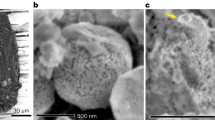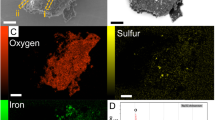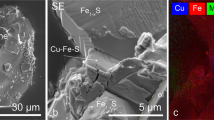Abstract
Although ferric iron indisputably exists on the highly reducing surface of the Moon, its formation mechanism and evolution are still under debate. Here we show that micrometeorite impact-induced charge disproportionation of iron could have produced the large amounts of ferric iron (average Fe3+/∑Fe > 0.4) in agglutinate melts returned by China’s Chang’e-5 mission. The charge disproportionation reaction synchronously generated nanophase metallic iron (npFe0), and quantitative analyses of iron valence indicate that it is a dominant pathway for formation of npFe0 within the lunar agglutinate glass. The discovery of the charge disproportionation reaction in the agglutinates suggests that much more Fe3+ could be present on the Moon than previously thought, and that its abundance is progressively increasing with micrometeoroid impacts.
This is a preview of subscription content, access via your institution
Access options
Access Nature and 54 other Nature Portfolio journals
Get Nature+, our best-value online-access subscription
$29.99 / 30 days
cancel any time
Subscribe to this journal
Receive 12 digital issues and online access to articles
$119.00 per year
only $9.92 per issue
Buy this article
- Purchase on Springer Link
- Instant access to full article PDF
Prices may be subject to local taxes which are calculated during checkout



Similar content being viewed by others
Data availability
The experiment data that support the findings of this study are available via the figshare repository at https://doi.org/10.6084/m9.figshare.21382611.v1 (ref. 43).
References
McCanta, M. C., Dyar, M. D., Lanzirotti, A., Newville, M. & Breitenfeld, L. B. In-situ mapping of ferric iron variations in lunar glasses using X-ray absorption spectroscopy. Am. Mineral. 104, 453–458 (2019).
Grossman, L., Beckett, J. R., Fedkin, A. V., Simon, S. B. & Ciesla, F. J. Redox conditions in the solar nebula: observational, experimental, and theoretical constraints. Rev. Mineral. Geochem. 68, 93–140 (2008).
Ronald Frost, B. Introduction to oxygen fugacity and its petrologic importance. Rev. Mineral. Geochem. 25, 1–9 (1991).
Taylor, G. J. et al. in Lunar Sourcebook. A User’s Guide to the Moon (eds Heiken, G. H. et al.) 183–284 (Cambridge University Press, 1991).
Housley, R. M., Blander, M., Abdel-Gawad, M., Grant, R. W. & Muir, A. H. Jr. Mössbauer spectroscopy of Apollo 11 samples. Geochim. Cosmochim. Acta Supp. 1, 2251–2268 (1970).
McCanta, M. C. et al. In situ measurement of ferric iron in lunar glass beads using Fe-XAS. Icarus 285, 95–102 (2017).
Burgess, K. D. & Stroud, R. M. Coordinated nanoscale compositional and oxidation state measurements of lunar space-weathered material. J. Geophys. Res. Planets 123, 2022–2037 (2018).
Thompson, M. S., Zega, T. J., Becerra, P., Keane, J. T. & Byrne, S. The oxidation state of nanophase Fe particles in lunar soil: implications for space weathering. Meteorit. Planet. Sci. 51, 1082–1095 (2016).
Li, S. et al. Widespread hematite at high latitudes of the Moon. Sci. Adv. 6, eaba1940 (2020).
Dyar, M. D. & Consolmagno, G. J. Ferric iron in lunar glasses and the interpretation of lunar spectra. Proc. Lunar Planet. Sci. 13, 193–194 (1982).
Schürmann, K. & Hafner, S. S. On the amount of ferric iron in plagioclases from lunar igneous rocks. Proc. Lunar Planet. Sci. 3, 615–621 (1972).
Niebuhr, H. H., Zeira, S. & Hafner, S. S. Ferric iron in plagioclase crystals from anorthosite 15415. Proc. Lunar Planet. Sci. 4, 971–982 (1973).
Cocks, F. Lunar ice: adsorbed water on subsurface polar dust. Icarus 160, 386–397 (2002).
Stopar, J. D., Jolliff, B. L., Speyerer, E. J., Asphaug, E. I. & Robinson, M. S. Potential impact-induced water–solid reactions on the Moon. Planet. Space Sci. 162, 157–169 (2018).
Hicks, L. J. et al. Fe‐redox changes in Itokawa space‐weathered rims. Meteorit. Planet. Sci. 55, 2599–2618 (2020).
Terada, K. et al. Biogenic oxygen from Earth transported to the Moon by a wind of magnetospheric ions. Nat. Astron. 1, 0026 (2017).
Pieters, C. M. & Noble, S. K. Space weathering on airless bodies. J. Geophys. Res. Planets 121, 1865–1884 (2016).
Pieters, C. M. et al. Space weathering on airless bodies: resolving a mystery with lunar samples. Meteorit. Planet. Sci. 35, 1101–1107 (2000).
Gu, L. et al. Space weathering of the Chang’e‐5 lunar sample from a mid‐high latitude region on the Moon. Geophys. Res. Lett. 9, e2022GL097875 (2022).
Hapke, B. Space weathering from Mercury to the asteroid belt. J. Geophys. Res. Planets 106, 10039–10073 (2001).
Li, C. et al. Characteristics of the lunar samples returned by the Chang’E-5 mission. Nat. Sci. Rev. 9, nwab188 (2022).
Badyukov, D. D. Micrometeoroids: the flux on the Moon and a source of volatiles. Sol. Syst. Res. 54, 263–274 (2020).
Basu, A. Nanophase Fe0 in lunar soils. J. Earth Syst. Sci. 114, 375–380 (2005).
Basu, A., Wentworth, S. J. & Mckay, D. S. Heterogeneous agglutinitic glass and the fusion of the finest fraction (F3) model. Meteorit. Planet. Sci. 37, 1835–1842 (2002).
Keller, L. P. & Clemett, S. J. Formation of nanophase iron in the lunar regolith. Proc. Lunar Planet. Sci. 32, 2097 (2001).
James, C. L., Letsinger, S. L., Basu, A., Wentworth, S. J. & McKay, D. S. Size distribution of Fe0 globules in lunar agglutinitic glass. Proc. Lunar Planet. Sci. 33, 1827 (2002).
Enju, S. et al. Condensation of cometary silicate dust using an induction thermal plasma system. II. Mg–Fe–Si–O–S system and the effects of sulfur and redox conditions. Astron. Astrophys. 661, A121 (2022).
Garvie, L. A. J., Craven, A. J. & Brydson, R. Use of electron-energy loss near-edge fine structure in the study of minerals. Am. Mineral. 79, 411–425 (1994).
Garvie, L. A. J. & Buseck, P. R. Ratios of ferrous to ferric iron from nanometre-sized areas in minerals. Nature 396, 667–670 (1998).
van Aken, P. A., Liebscher, B. & Styrsa, V. J. Quantitative determination of iron oxidation states in minerals using Fe L2,3-edge electron energy-loss near-edge structure spectroscopy. Phys. Chem. Miner. 25, 323–327 (1998).
van Aken, P. A. & Liebscher, B. Quantification of ferrous/ferric ratios in minerals: new evaluation schemes of Fe L23 electron energy-loss near-edge spectra. Phys. Chem. Miner. 29, 188–200 (2002).
McKay, D. S. et al. in Lunar Sourcebook. A User’s Guide to the Moon (eds Heiken, G. H. et al.) 285–356 (Cambridge University Press, 1991).
Cooper, R. F., Fanselow, J. B., Weber, J. K. R., Merkley, D. R. & Poker, D. B. Dynamics of oxidation of a Fe2+-bearing aluminosilicate (basaltic) melt. Science 274, 1173–1176 (1996).
Cooper, R. F., Fanselow, J. B. & Poker, D. B. The mechanism of oxidation of a basaltic glass: chemical diffusion of network-modifying cations. Geochim. Cosmochim. Acta 60, 3253–3265 (1996).
Nanda, K. K., Sahu, S. N. & Behera, S. N. Liquid-drop model for the size-dependent melting of low-dimensional systems. Phys. Rev. A 66, 13208 (2002).
Judge, W. D., Allanore, A., Sadoway, D. R. & Azimi, G. E-logpO2 diagrams for ironmaking by molten oxide electrolysis. Electrochim. Acta 247, 1088–1094 (2017).
Hu, J. & Sharp, T. G. Formation, preservation and extinction of high-pressure minerals in meteorites: temperature effects in shock metamorphism and shock classification. Prog. Earth Planet. Sci. 9, 6 (2022).
Bindi, L., Shim, S.-H., Sharp, T. G. & Xie, X. Evidence for the charge disproportionation of iron in extraterrestrial bridgmanite. Sci. Adv. 6, eaay7893 (2020).
Yakovlev, O. I., Dikov, Y. P. & Gerasimov, M. V. Effect of the disproportionation reaction of ferrous iron in impact-evaporation processes. Geochem. Int. 47, 134–142 (2009).
Dikov, Y. P., Gerasimov, M. V., Yakovlev, O. I. & Ivanov, A. V. Valence state of iron in a condensate from the Luna 16 regolith. Petrology 17, 429–438 (2009).
Cross, W., Iddings, J. P., Pirsson, L. V. & Washington, H. S. A quantitative chemico-mineralogical classification and nomenclature of igneous rocks. J. Geol. 10, 555–690 (1902).
Hanwell, M. D. et al. Tomviz: open source platform connecting image processing pipelines to GPU accelerated 3D visualization. Microsc. Microanal. 25, 408–409 (2019).
Xian, H. Raw data for ‘Ubiquitous and progressively increasing ferric iron content on the lunar surfaces revealed by Chang’E-5 samples’. figshare https://doi.org/10.6084/m9.figshare.21382611.v1 (2022).
Ground Research and Application System of China’s Lunar and Planetary Exploration Program. Chang’e 3 Topographic Camera Dataset (China National Space Administration, 2013); http://moon.bao.ac.cn
Acknowledgements
We thank all the team members of China’s Chang’e Lunar Exploration Project for their hard work in returning lunar samples and CNSA for providing the lunar sample CE5C0400YJFM00408. We thank M. Chen for the helpful discussion on the early version of the scientific story. This study was supported by the Special Lunar Project of Chinese Academy of Sciences (ZDBS-SSW-JSC007-11) to Y.-G.X., the Director’s Fund of Guangzhou Institute of Geochemistry, CAS (2022SZJJZD-03) to J.Z., H.X, Y.Y. and X.L and the Youth Innovation Promotion Association CAS (2021353) to H.X. This is contribution No. IS-3264 from GIGCAS.
Author information
Authors and Affiliations
Contributions
H.H. and Y.-G.X. supervised the project. H.X. and J.Z. designed the project. H.X. wrote the draft manuscript. H.X., Y.Y. and S.L. performed TEM-EELS data collection. H.X., Q.Z., H.Y. and A.T. performed SEM data collection. X.L., J. Xi, J. Xing and X.W. participated in data interpretation and editing of the manuscript.
Corresponding authors
Ethics declarations
Competing interests
The authors declare no competing interests.
Peer review
Peer review information
Nature Astronomy thanks John Bridges and Thomas Zega for their contribution to the peer review of this work.
Additional information
Publisher’s note Springer Nature remains neutral with regard to jurisdictional claims in published maps and institutional affiliations.
Extended data
Extended Data Fig. 1 Melt splashes on the surface of a CE5 agglutinate particle.
The brushed melts on the glass suggest repeated micrometeoroid impacts experienced by the agglutinate paticle.
Extended Data Fig. 2 Microscopic chemical compositions of the CE5 agglutinate glass.
HAADF-STEM image (a), elemental EDS maps (b–h), and selected area EDS spectra (i) of the same area shown in Fig. 1c,d of the main text.
Extended Data Fig. 3 Peak position and shape comparation of intensity normalized Fe L2,3 EELS spectra of metallic Fe0, olivine, and hematite.
The Fe0 and Fe2+ have a typical Fe L3 peak positions at 708.1–708.9 eV while the Fe3+ has a typical Fe L3 peak position at 709.9 eV. The normalized intensity of the peak tail of Fe0 at 730 eV is 2 times higher than those of Fe2+ and Fe3+. The full width at half maximum (FWHM) of Fe0 L3 peak (3.9 eV) is larger than those of Fe2+ and Fe3+ L3 peaks (~3.4 eV). The green arrow indicates the high-tail feature of Fe L-edge for metallic Fe0, while the orange arrow indicates the relative low-tail features of Fe L-edges for both olivine and hematite.
Extended Data Fig. 4 Iron valence distribution of the analyzed zone No. 2 from the CE5 agglutinate glass.
HAADF-STEM image (a), EELS Fe valent map (b), Fe3+/Fe ratios map (c), and the frequency and cumulative distributions (d) of the Fe3+/∑Fe ratios of a randomly chosen zone in the CE5 agglutinate.
Extended Data Fig. 5 Iron valence distribution of the analyzed zone No. 3 from the CE5 agglutinate glass.
HAADF-STEM image (a), EELS Fe valent map (b), Fe3+/∑Fe ratios map (c), and the frequency and cumulative distributions (d) of the Fe3+/∑Fe ratios of another randomly chosen zone in the CE5 agglutinate.
Extended Data Fig. 6 The relationship between the particle size and melting temperature (Tm) of iron nanospheres.
The bulk melting temperature (Tmb =1536ºC) is indicated by the blue dashed line.The black dotted line and arrow indicate estimated melting temperature (1524ºC) for the largest npFe0 in the studied agglutinate glass.
Extended Data Fig. 7 Schematic illustration of the micrometeorite impact-induced ferrous charge disproportionation reaction.
The topographic base was adapted with permission from Ground Research and Application System of China’s Lunar and Planetary Exploration Program (http://moon.bao.ac.cn)44.
Supplementary information
Supplementary Information
Supplementary Table 1.
Supplementary Video
3D-view movie of Fe valence state dispersion in agglutinate glass.
Supplementary Data 1
Abundance calculation details of various valent iron species in agglutinate glass.
Rights and permissions
Springer Nature or its licensor (e.g. a society or other partner) holds exclusive rights to this article under a publishing agreement with the author(s) or other rightsholder(s); author self-archiving of the accepted manuscript version of this article is solely governed by the terms of such publishing agreement and applicable law.
About this article
Cite this article
Xian, H., Zhu, J., Yang, Y. et al. Ubiquitous and progressively increasing ferric iron content on the lunar surfaces revealed by the Chang’e-5 sample. Nat Astron 7, 280–286 (2023). https://doi.org/10.1038/s41550-022-01855-0
Received:
Accepted:
Published:
Issue Date:
DOI: https://doi.org/10.1038/s41550-022-01855-0
This article is cited by
-
Measurement of ferric iron in Chang’e-5 impact glass beads
Earth, Planets and Space (2023)



